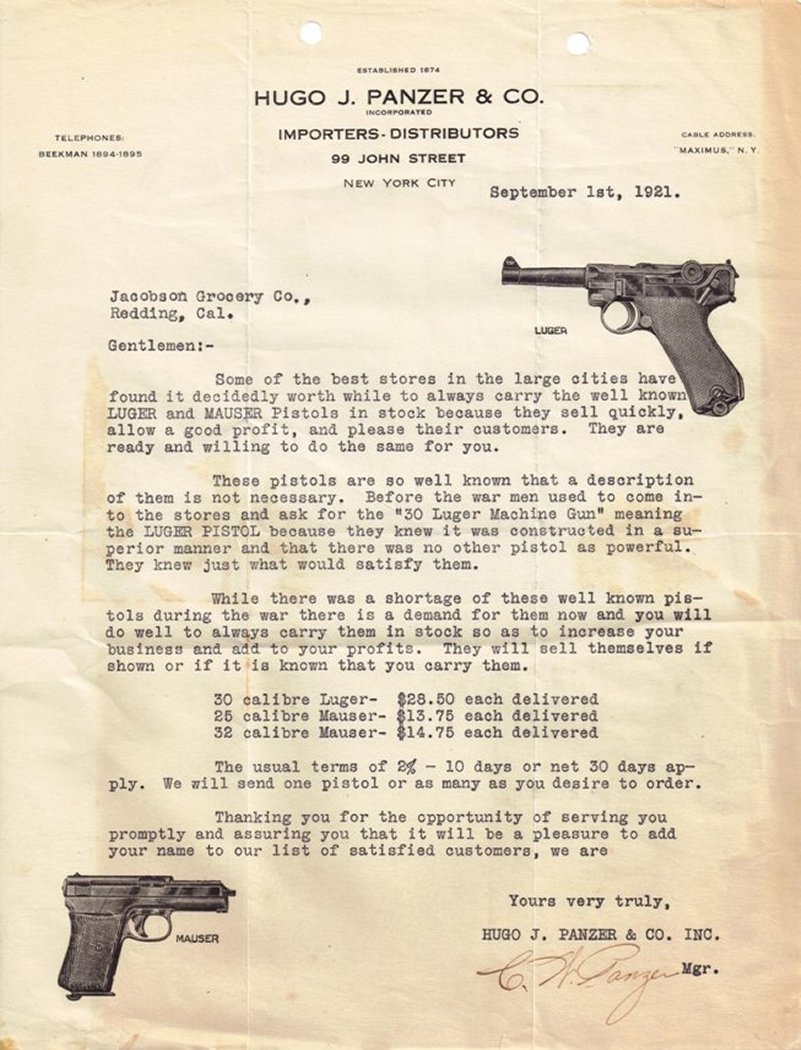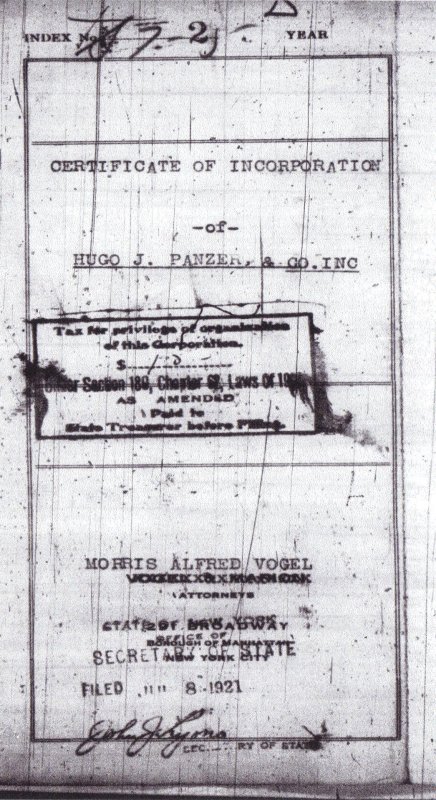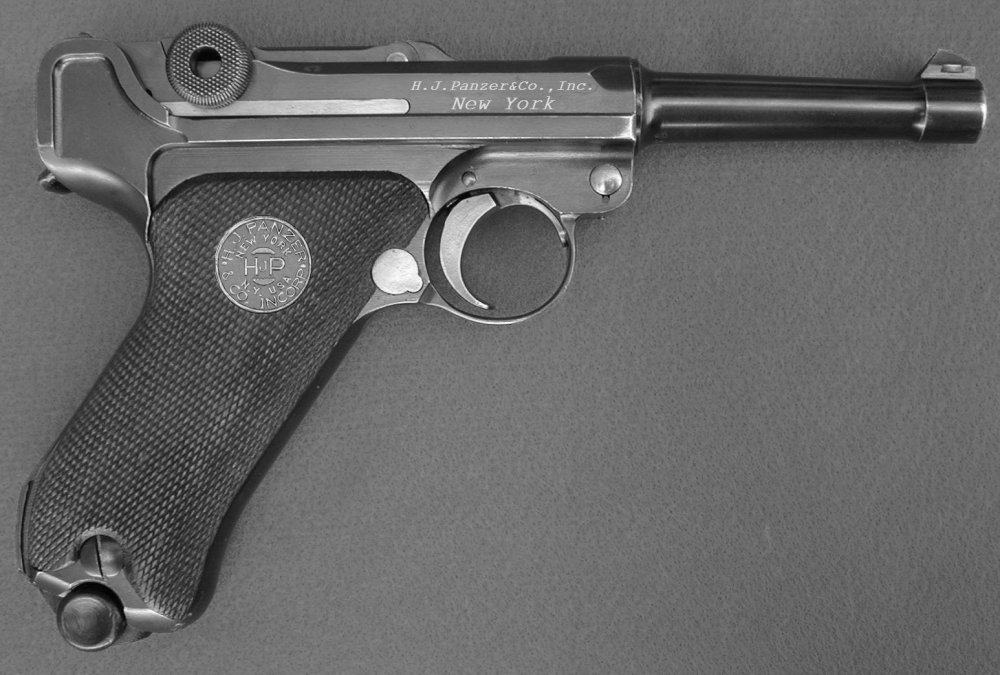Hugo J. Panzer & Company, Inc.
 Text Resize |
BackgroundHugo J. Panzer & Company, 9 John Street, New York City. This business was granted an exclusive Parabellum agency by the Alien Property Custodian, who had seized the business of Hans Tauscher, shortly after the April 17, 1917 United States entry into the War. However, no Panzer-marked pistols have ever been identified and it is suspected that a different trading name was used (Transatlantic Import Co.’?). After the involvement with Stoeger, Panzer withdrew from the Luger industry and the company’s fate is not known.1 On 11 January 1922, rights to the Luger patents and the associated pistol business were transferred by the Alien Property Commission to Hugo J. Panzer & Co. Ltd.2 of New York. The management of BKIW, as DWM had become, protested vigorously that a sole agency had already been promised to A.F. Stoeger & Company of New York; indeed, on the basis of this agreement Stoeger had acquired refurbished or-assembly guns from Germany as early as June 19213. The Alien Property Custodian declined to arbitrate, but the two distributors eventually agreed to recognize Stoeger as ‘sole agency’. Stoeger would then sell imported guns to Panzer until the arrangement lapsed.4 In the spring of 1922, BKIW finally granted distribution of the Luger to A.F. Stoeger Company. Continual bickering between Stoeger and Hugo J. Panzer & Company, to whom the guns delivered to Hans Tauscher prior to 1917 had been given, had begun with the earliest shipment of newly made guns from Germany. However, Panzer soon lost interest and assigned all rights to in the Luger to Stoeger in March 19245. DWM, now BKIW, apparently delayed recommencement of production until c.1923.6 Per Eugene Bender in Luger Holsters and Accessories: On July 25, 1921 he (Stoeger) sent a one-page flyer to the wholesale jobbing trade announcing that his firm was the exclusive importer for Mauser automatic Pistols and rifles and for Luger automatic pistols.7 The Hugo J. Panzer Company, Incorporated, basically lost their franchise or monopoly as the sole importer/distributor of the Luger in the United States in March of 1922 when Stoeger took over. The nature and method of transfer from Panzer to Stoeger has been briefly discussed in only two books, by the same author, presented herein, and has been speculated/repeated in Luger forums, mostly concentrating on the more well known Stoeger Company, yet with no more information being offered on Panzer, and as such, will not be discussed here, except in relation to the subject Hugo J. Panzer letter.

It is interesting to note that when Stoeger issued their, possibly premature, one-page flyer (shown above) proclaiming to be the sole or "exclusive" United States importer of Lugers on July 25, 19218, that, as of that date, the Alien Property Custodian Agency had not yet assigned the Hans Tauscher business and patent rights to the Hugo J. Panzer & Co., Inc. Also that the Hugo J. Panzer, Co., at the time, was already a well-established importer in the United States since 1874, almost fifty years before the upstart Stoeger & Co. was established in 1918. Prior to being assigned the Tauscher business, Panzer also had dealings with DWM as attested by the by the September 1921 dated Panzer subject letter. It is interesting that with all the years of accumulated business experience and acumen that it was not Panzer that "cut" a deal with DWM. It is clear, however, based on the publicly issued/referenced Stoeger letter, that despite the authority of the Alien Property Custodian agency, that they apparently had no control or influence after the war on the dealings, et. al., of American importers with foreign suppliers, in this case Germany. Yet apparently, they did have the authority to assign the Tauscher business to Panzer, which started the bickering between Panzer and Stoeger. It was Stoeger who eventually acquired the Luger business as sole importer of Lugers in the United States. Stoeger had to have been a well-funded, very ambitious individual, i.e. company, astutely contracting a rather large order from DWM months earlier. One has to assume that DWM was very anxious for new business in 1921. In addition, politically speaking, the German firm of DWM in June 1921 would not have any empathy with a United States government agency whose sole existence was to confiscate German businesses and fortunes during the war, or for that matter, any decisions they made after the war regarding confiscated German assets for the same reasons, especially decisions not in their favor regarding German financial concerns, would therefore, in part, account for DWMs early on strong support of Stoeger to represent their arms business interests in the United States. The letter
Featured above is the only known published Hugo J. Panzer sales correspondence letter, hand typed and signed in ink, to a prospective retailer in Redding California, dated 1 September 19219. The letter has survived in excellent condition for eighty-eight years due, in part, because it was typed on high quality HAMMERMILL BOND stationery of which the arched Hammermill Bond watermark name or logo can be seen in two places on the document when held up to the light. Another reason for its survival, for its otherwise being a relatively obscure document, is due to its being recognized early on as valuable original Luger literature, being obtained from a collector who had it for at least forty years. The billing terms in the letter of 2/10 net 30, referred to as "two ten net 30," meant that the merchant could subtract 10% of the bill if the bill was paid within the first ten days. After the tenth day, the merchant would owe the full amount of the bill. After thirty days, an interest penalty could be incurred. The letter was written about five months prior to 11 January 1922 when Hugo J. Panzer & Company, Incorporated, had been granted the Parabellum agency, formally of Hans Tauscher, by the United States Alien Property Custodian. The letterhead indicates the company was established in 1874 yet it was not incorporated until 9 July 1921, as published per The New York Times list of "New Incorporations": Hugo J. Panzer & Co., Manhattan, merchandise, $10,000; H. J. and C. and O. Penger; attorney, M.A. Vogel, 201 Broadway.10 This is very coincidental as Panzer was assigned as the exclusive Parabellum agency by the Alien Property Custodian, only seven months later on 11 January 1922. Since the Hans Tauscher business and assets were seized in 1917 and not awarded to Panzer until January 1922 leaves approximately a four-year gap, technically, where Hans Tauscher business assets were frozen in the United States as attested by certain Tauscher assets, including Lugers and one assumes Luger accessories, that were confiscated by the Alien Property Custodian in 1917, however it was the Luger "confiscated" accessories, as identified by Costanzo11 that were sold at auction on July 20, 192112. The successful bidder is not known. This auction is unusual as it took place six months before Panzer was assigned the Luger patent rights and Tauscher’s associated pistol business, which according to John Walters included; all unsold Lugers delivered to Tauscher prior to 1917. One has to assume, based on the documented series of events that the Tauscher assets, assigned to Panzer in January 1922 did not include Luger accessories such as holsters, magazines, stocks, ammunition, drums and leather carriers. The situation of no assigned sole importer/distributor of Lugers in the United States during this time frame of 1917-1922, apparently, did not affect the sale of existing stock, or importation of new Lugers, almost immediately after the war, as Panzer and Stoeger and certainly other domestic firms were importing and selling Lugers, possibly as early as 1919. As an example of what little is known about the Hugo J. Panzer & Company, Inc. is for years the scant information published on Panzer had the wrong New York City address of 9 John Street where, per the subject letterhead, the correct address is 99 John Street.13 However, there is no doubt as to the association of Panzer to the Luger pistol as the Panzer letterhead included a picture of a Luger at the top, along with a Mauser Pocket Pistol at the bottom of the page. Although Panzer talks about both the Luger and the Mauser Pocket pistol in the subject letter, it is significant that the Luger pistol is pictured at the top of the letter and discussed additionally in the body of the letter. It is the Luger that was emphasized or extolled, ergo: Before the war men used to come in to the stores and ask for the "30 Luger Machine Gun" meaning the LUGER PISTOL….. It is also interesting that the Hugo J. Panzer & Company, Inc. was a family-run business as evidenced by the letter signature of C. W. Panzer. Research of the State of New York Archives has discovered that the Hugo J. Panzer & Company, Inc was a family partnership of three: Hugo J. Panzer, Crosswood W. Panzer and Otto Panzer. This was determined by examination of the July 8, 1921 New York City Hugo J. Panzer Co. Certificate of Incorporation documents shown below. Pictured are the only known signatures of the three Panzer partners.

One possible reason that Panzer was initially assigned the Luger "business", which is pure speculation, was probably political in nature, in that Panzer could have had influence with members of the Alien Property Custodian Agency whereas Stoeger was intimate with DWM, to be later become BKIW, having placed large orders in early 1921. The most important influence as it turns out, in the end, was the tight relationship established between Stoeger and DWM. Based on the 1921 dated subject letter where Panzer was exclusively advertising the .30 Cal commercial Luger, it is not clear as to Panzer’s supply source of the Luger. In all probability, it was DWM and that Panzer’s other source of Lugers was either Hans Tauscher expropriated, unsold pre World War 1 commercial Lugers, although these were not available until after 11 January 1922. These pre WW1 commercial Lugers would have a receiver left side horizontal crown N or Nitro commercial proof with serial numbers no higher than 75000 or DWM 1919 to 1921 new manufacture commercial Lugers up to serial number 92000 or 1921 and later reworked World War 1 Lugers with serial numbers starting in the four digit i suffix range or a combination of all three. As a matter of note, five digit commercial Lugers starting at about serial number 80000 the receiver left side crown N commercial proofing changed from a horizontal crown N to a vertical crown N, yet interestingly, some of the first four digit 2000i suffix Lugers manufactured in 1923 had the earlier horizontal crown N proof stamped the receiver left side. Later or higher four digit i suffix manufactured Lugers, the crown N proof is stamped vertically on the receiver left side. It should be noted that the company was still DWM until 30 May 1922, when it became BKIW. Since Hugo J. Panzer & Company, Inc., was assigned "sole agency" for the Luger in the United States on 11 January 1922, it would be bizarre, that in the 1920-1921 time frame, as stated by John Walter that Panzer would be provided Lugers by Stoeger, since both companies had access to new or refurbished DWM Lugers. Especially since it is also certain from the 1921 dated letter that Panzer had significant inventory on hand as Panzer states in his letter that: We will send you one pistol or as many as you desire to order. In order for the merchants who selected Panzer as their supplier of Lugers to make a profit, the end user retail price would have had to be in excess of $30 based on the subject letter. The price of $28.50, in the original subject Panzer letter, seems sort of high. However, based on the terms in the Panzer letter, merchants probably took advantage of the 10% discount, which made the end-retail price more competitive. The highest observed/identified retailer advertised price for a .30 Cal commercial Luger in the early 1920s was $28.50 by the Guarantee Trading Company, Jersey City, N.J. A 1922 ad by The Import Trading Company, based in New York City, could have been a Panzer customer as the ad comes close to replicating the subject Panzer letter pistol lineup. By the mid 1920s, prices had dropped to as low as $13.50 for the .30 Cal and 9 mm Lugers, as advertised by J. L. Galef in a 1924 catalog. Prices for the .30 Cal and 9 mm Luger pistol crept back up to $24.99 by 1931, as advertised by Arnold Wolf, Denver, CO. There are no identified circa 1920 commercial Luger ads for a "suggested retail price" of $37.50 as recommended by A.F. Stoeger in his July 25, 1921 letter. In all probability Panzer ordered from the printer a minimum of 100-1000 pages with the subject letterhead and given the tone and general subject content of the letter, in as much as it is not directed to any specific questions or enquiries from the referenced merchant, that it is a boilerplate letter sent to many prospective merchants in the United States for the intent to solicit business for the Hugo J. Panzer & Co., Inc. Assuming some Panzer correspondence survived, dated after 11 January 1922, it would be interesting to note if Panzer added another line or two to his letterhead stationery, namely:
Deutsche Waffen & Munitions Fabriken, Berlin, Germany.
 |
 Home page
Home page

